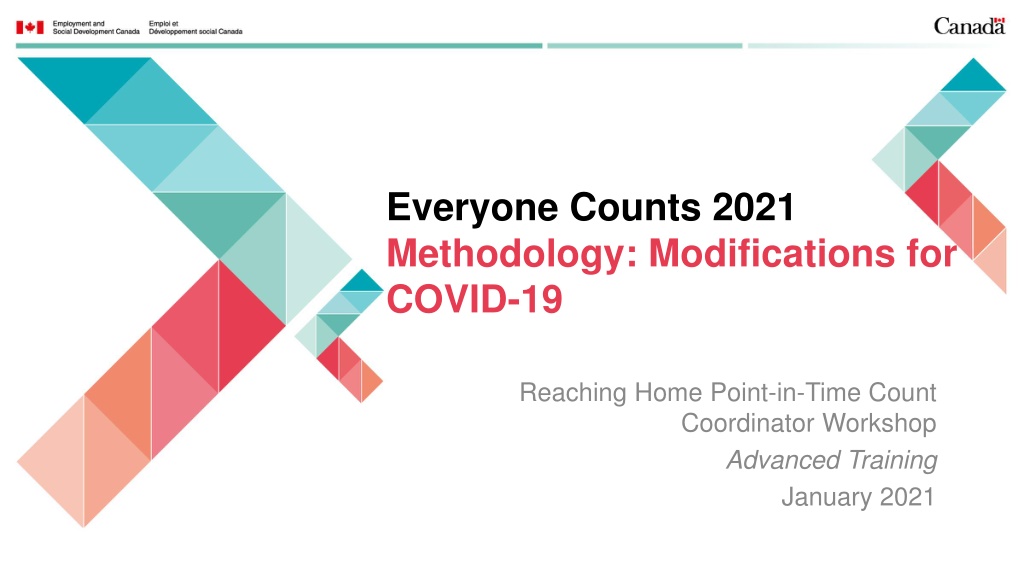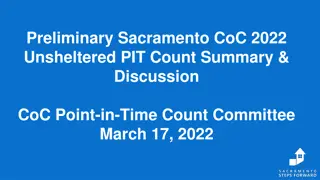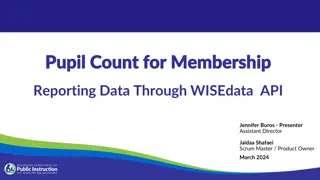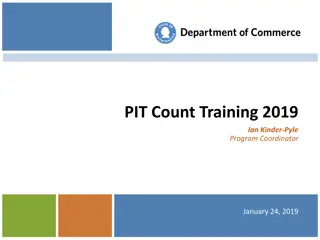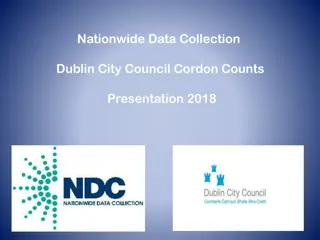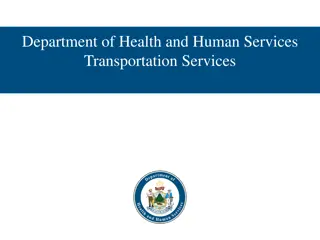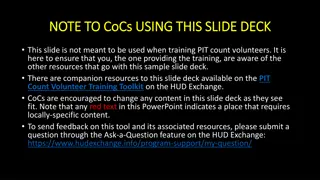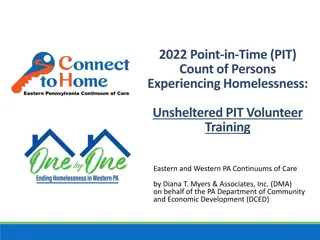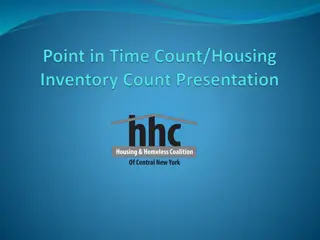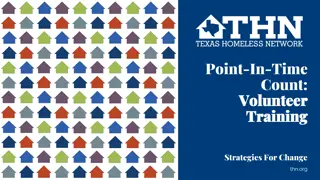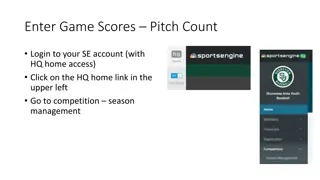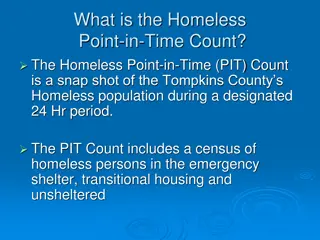Enhancing Safety Measures for the 2021 Everyone Counts Point-in-Time Count Workshop
The 2021 Everyone Counts workshop emphasizes enhanced safety measures due to COVID-19. Modifications to the Point-in-Time Count aim to reduce risks and ensure compliance with local health guidelines. The workshop covers elements like unsheltered and sheltered enumeration, surveys, and key decision scenarios. Safety protocols include providing masks, symptom checklists, virtual training, and hand sanitization.
Download Presentation

Please find below an Image/Link to download the presentation.
The content on the website is provided AS IS for your information and personal use only. It may not be sold, licensed, or shared on other websites without obtaining consent from the author. Download presentation by click this link. If you encounter any issues during the download, it is possible that the publisher has removed the file from their server.
E N D
Presentation Transcript
Everyone Counts 2021 Methodology: Modifications for COVID-19 Reaching Home Point-in-Time Count Coordinator Workshop Advanced Training January 2021
Safety is our top priority Local public health orders and guidelines should guide every decision on whether and how to proceed with your 2021 Point-in- Time Count The modifications that will be presented in this session have the goal of reducing COVID related risks that exist in a normal PiT Count If it is unsafe to conduct a count in your community this spring, you can further postpone Guidance provided here is based on information and guidelines published by the Public Health Agency of Canada, found here: canada.ca/covid19 Please consult with your local health authority and/or public health in planning your 2021 count 2
Unsheltered Enumeration Unsheltered Survey Sheltered Enumeration Sheltered Survey 3
Four elements of a PiT Count The unsheltered enumeration refers to the administration of the screening questions (has someone with this identifier approached you tonight and where are you staying tonight) to individuals on the street, in parks, transit hubs, etc. This also includes the observational tally, if your community uses it. The unsheltered survey refers to the administration of the full 15 question survey to these same folks, after they have screened in via the screening questions. The sheltered enumeration refers to the administrative data collected from shelters, transitional housing programs, and public systems, such as health care facilities and remand centres, if your community includes those. The sheltered survey refers to the administration of the full 15 question survey to individuals that are included in the sheltered enumeration. 4
Everyone Counts 2021 Outline: 1. Enhanced safety measures and considerations 2. Walkthrough of modifications to each count element a. Unsheltered enumeration b. Unsheltered survey c. Sheltered enumeration d. Sheltered survey 3. Example Scenarios a. Scenario 1: Implement enhanced safety measures b. Scenario 2: Maximize modifications with min change to collected data c. Scenario 3: Enumeration ONLY d. Scenario 4: Postponement 4. Key decisions
Enhanced safety measures and considerations For all elements that involve inter-personal interactions Provide masks for all participants (including survey respondents) Face shields should be considered for any interaction taking place indoors Administer COVID symptom checklist before allowing staff or volunteers to participate in the count Shift to virtual training for enumerators and surveyors Provide access to hand sanitizer and/or hand washing stations Reduce the size of enumeration teams Administer COVID symptom checklist for all potential survey respondents, and offer resources to connect individuals with a COVID test Instruct enumerators/surveyors to maintain social distancing throughout the duration of the Count 6
UNSHELTERED ENUMERATION Limit volunteers: Community volunteers normally play a large part of the unsheltered enumeration. You can limit enumerators to only those who work within the homeless-serving sector. Those who work in the sector will be familiar with and well- practiced in COVID safety protocols They may also have their own PPE, such as face shields 7
UNSHELTERED ENUMERATION Reduce the size of enumeration teams to 2 Experienced enumerators are familiar with the population and COVID safety procedures Teams usually consist of 3-5 volunteers, with a team lead. By using either only staff or only volunteers from within the homeless-serving sector, you can reduce the size of your teams to 2, since all those participating will have experience working with this population, as well as familiarity with client- facing COVID safety measures 8
UNSHELTERED ENUMERATION Restrict enumeration to staff only This can mean outreach teams and in-house staff at your organization 9
UNSHELTERED ENUMERATION Extend the normal enumeration window: Use the full 24 hours allotted Oftentimes, the bulk of the unsheltered enumeration takes place in a 2-3 hour window by volunteers. However, your enumeration spans an entire 24-hour period, so take advantage of that if you can Encampments especially can and should be enumerated during daylight hours 10
UNSHELTERED SURVEY Extend the normal survey window up to 3 days post- count date If administering the survey in a 24 hour period to all unsheltered individuals in your community is not feasible due to limited numbers of surveyors, the survey may be administered over the 3 days following the enumeration. The screening questions would be altered to ask where the participant spent the night of the count. 11
UNSHELTERED SURVEY Postpone: If it is assessed that the survey cannot be administered safely to unsheltered individuals OR you and your count partners decide that there are insufficient human resources to do so, please contact ESDC at hpsr@hrsdc-rhdcc.gc.ca to discuss postponement. 12
SHELTERED ENUMERATION Collect administrative data: The sheltered enumeration relies on data pulled from shelters and transitional housing programs information systems. Because of this, ability to collect the same data as in years past should be relatively unaffected by the pandemic. NOTE: Include new sites - Remember to include individuals in isolation sites like hotels for folks who have suspected or confirmed COVID. Only include those that are housing individuals who would otherwise be homeless 13
SHELTERED SURVEY Limit volunteers: If volunteers are not permitted in shelters, the survey will need to be administered by staff 14
SHELTERED SURVEY Extend the normal survey window: Up to 2 weeks after the night of the count. The survey would begin by asking the participant where they spent the night on the specified count date. 15
SHELTERED SURVEY Postpone: If it is assessed that the survey cannot be administered safely to sheltered individuals OR you and your count partners decide that there are insufficient human resources to do so, please contact ESDC at hpsr@hrsdc-rhdcc.gc.ca to discuss postponement. 16
EXAMPLE SCENARIOS COVID-19 Community Impact PiT Count components Scenario 1 Scenario 2 Scenario 3 Scenario 4 One-night count Enhanced safety measures: Practicing physical distancing Masking/Hand sanitizer/Face shields Smaller enumeration teams Virtual training One-night count Scenario 1 safety measures PLUS: Volunteers only from within Homeless-serving sector One-night count Scenario 1 modifications PLUS: Staff only Unsheltered enumeration (screening questions only) Enumeration Administrative data No modifications Administrative data No modifications Administrative data No modifications Sheltered Enumeration Standard methodology Enhanced safety measures: Practicing physical distancing Masking/Hand sanitizer/Face shields Smaller enumeration teams Virtual training Modified Scenario 1 safety measures PLUS: Administered over several days Administered separately from the one-night enumeration Volunteers only from within Homeless-serving sector Postpone Contact ESDC Survey (unsheltered) Contact ESDC Survey Standard methodology Enhanced safety measures: Practicing physical distancing Masking/Hand sanitizer/Face shields No volunteers (administered by staff) Modified Scenario 1 measures PLUS: Administered over several weeks Postpone Contact ESDC Survey (sheltered) 17
EXAMPLE Scenario 1: Lowest level of risk Implement enhanced safety measures In addition to the safety measures listed on slide #6 (masks, virtual training, incorporating COVID symptom checklist, etc) 18
EXAMPLE: Scenario 1 Unsheltered Homelessness Reduce the size of teams for the unsheltered enumeration and survey Administer the survey in conjunction with the screening questions 19
EXAMPLE: Scenario 1 Sheltered Homelessness Limit volunteers for the sheltered survey Collect administrative data for the sheltered enumeration as normal 20
EXAMPLE Scenario 2: Increasing risk and burden Maximum modifications with minimal change to collected data In addition to the safety measures listed on slide #6 and the modifications in Scenario 1 21
EXAMPLE: Scenario 2 Unsheltered Homelessness Limit volunteers for the unsheltered enumeration & survey to only those who work within the homeless- serving sector Reduce the size of enumeration teams to 2 since experienced enumerators are familiar with the population Extend the normal survey window up to 3 days post- count date 22
EXAMPLE: Scenario 2 Sheltered Homelessness Collect administrative data for the sheltered enumeration as normal Extend the normal survey window: Up to 2 weeks after the night of the count. The survey would begin by asking the participant where they spent the night on the specified count date 23
EXAMPLE Scenario 3: Elevated risk and burden Enumeration ONLY 24
EXAMPLE: Scenario 3 Unsheltered & Sheltered Homelessness Postpone survey administration: Please contact ESDC at hpsr@hrsdc-rhdcc.gc.ca to discuss postponement. 25
EXAMPLE: Scenario 3 Unsheltered Homelessness Restrict unsheltered enumeration to staff only Take advantage of the entire 24-hour enumeration window Sheltered Homelessness Collect administrative data for the sheltered enumeration as normal 26
EXAMPLE Scenario 4: Postponement of enumeration and survey Please contact ESDC at hpsr@hrsdc-rhdcc.gc.ca to discuss plans for further postponement. 27
Key Decision 1: Can you collect administrative data on sheltered individuals? Think about what has changed since your preparations a year ago Staff changes Staff capacity Additional shelters or transitional housing programs to include? 28
Key Decision 2: Can you enumerate unsheltered individuals in your community? Refers to administering screening questions ONLY Do you have the resources to implement the planning? Do you have the resources to cover comparable ground as your 2018 count? Can you cover less ground by using a sampling approach? Can you cover comparable ground by spreading out the enumeration over a full 24 hours? 29
Key Decision 3: Can you survey unsheltered individuals in your community? Characteristics of unsheltered individuals are lesser known If your community will be carrying out an unsheltered enumeration, how much added work/time will it take to administer the survey? Will you be able to cover as much ground as you have in past counts? Will administering the survey change that? 30
Key Decision 4: Can you survey sheltered individuals in your community? Remember: Rather than administering these surveys in one day, you can administer them over 2 weeks. Are outsiders allowed into your local shelters? Are your count partners shelter providers, etc on board for administering surveys? 31
Everyone Counts 2021 Thank you! Questions? Comments?
